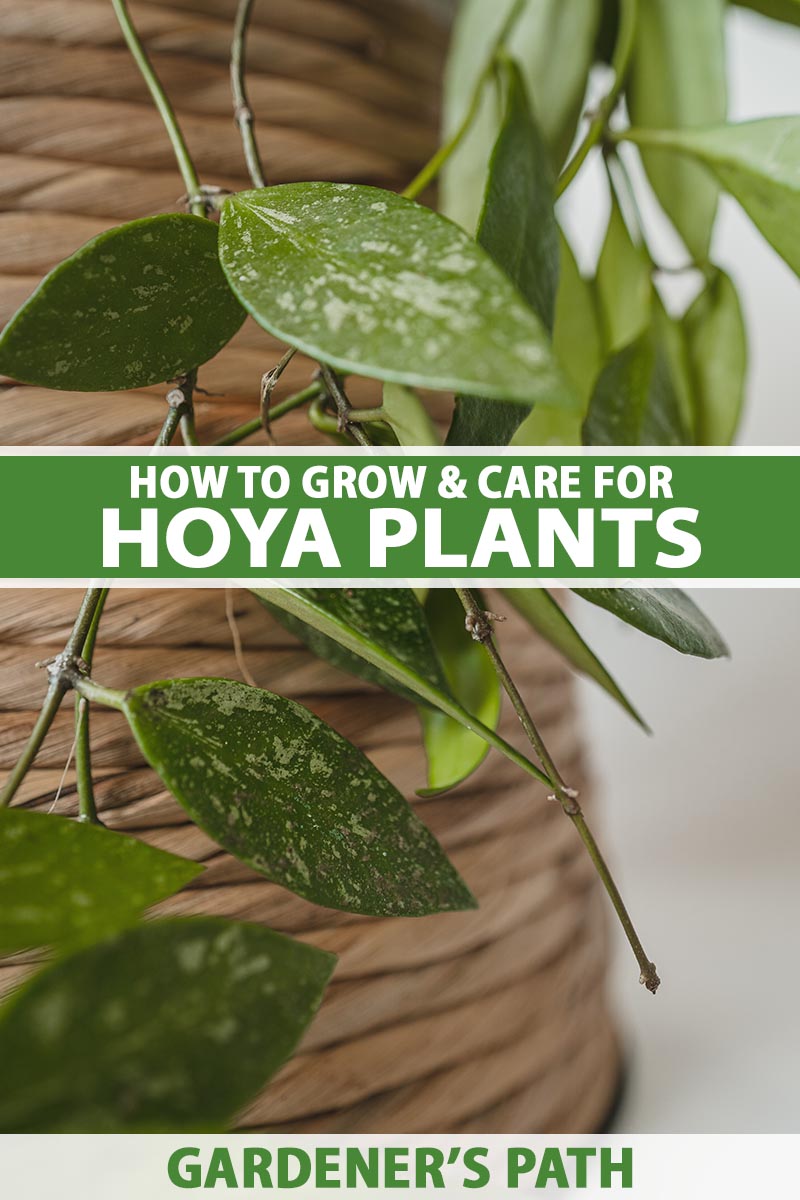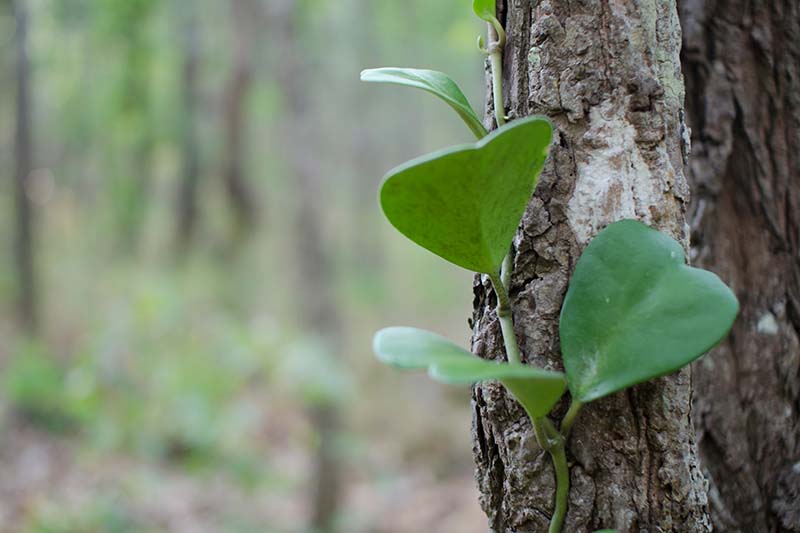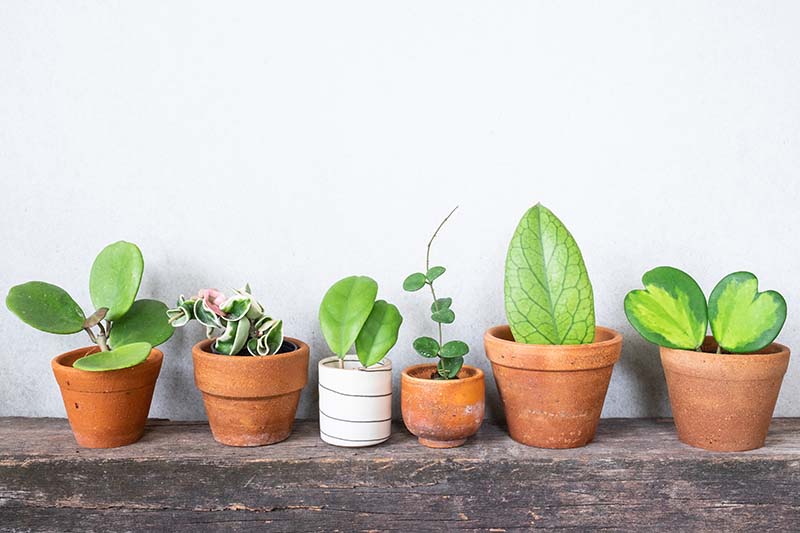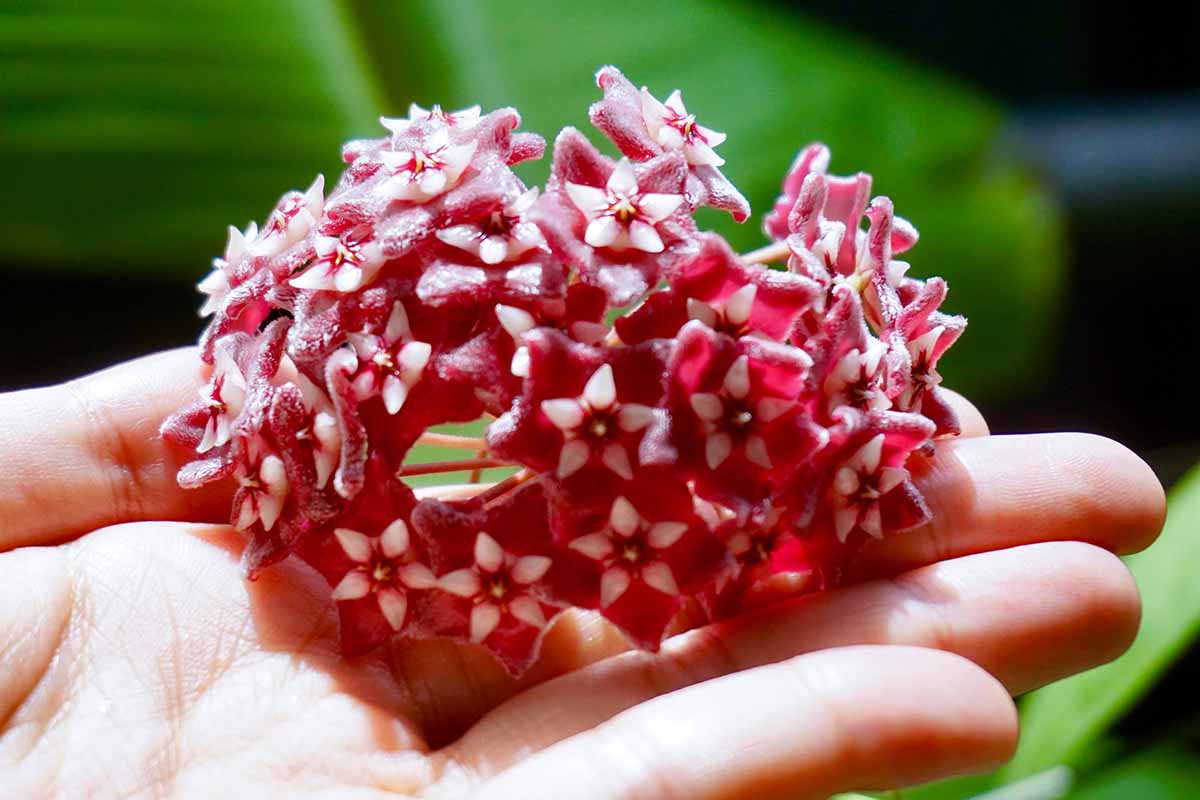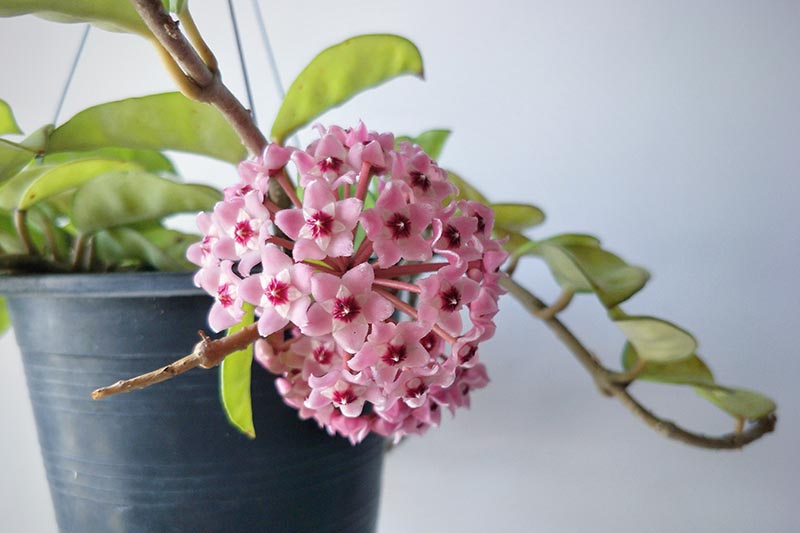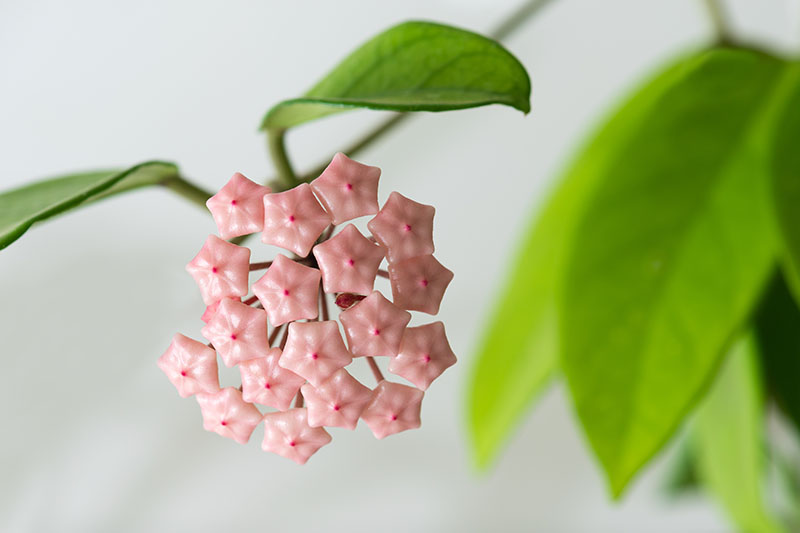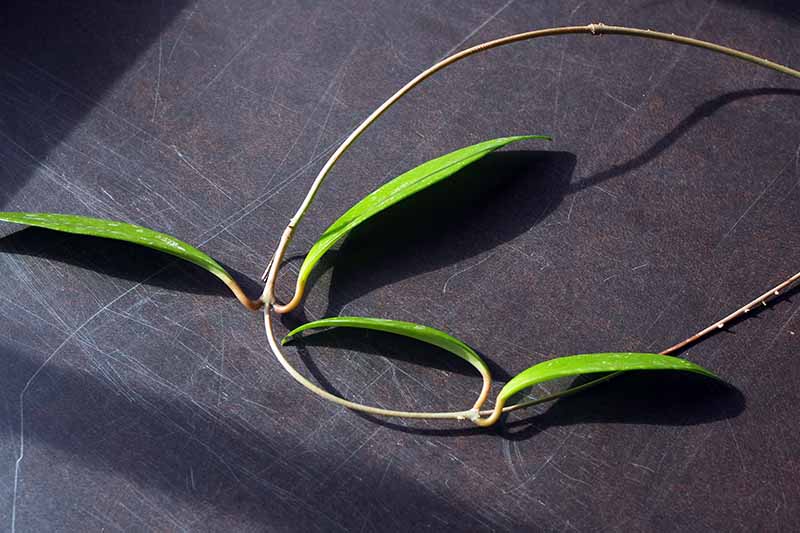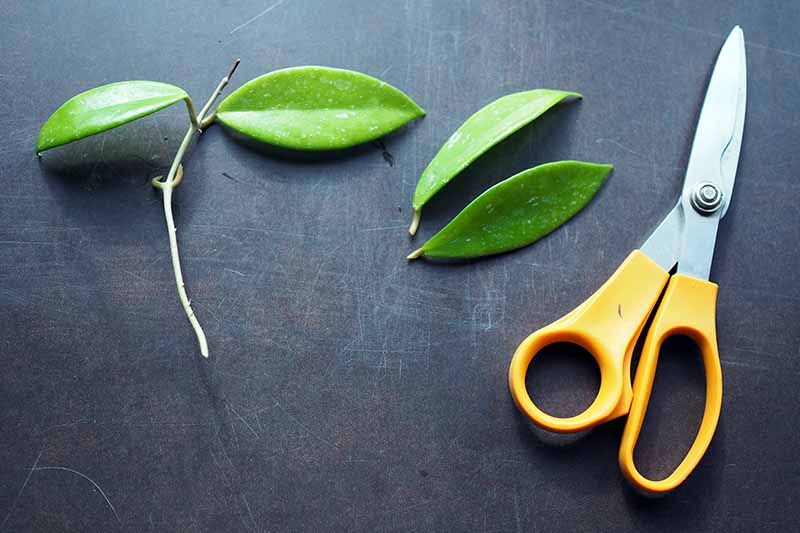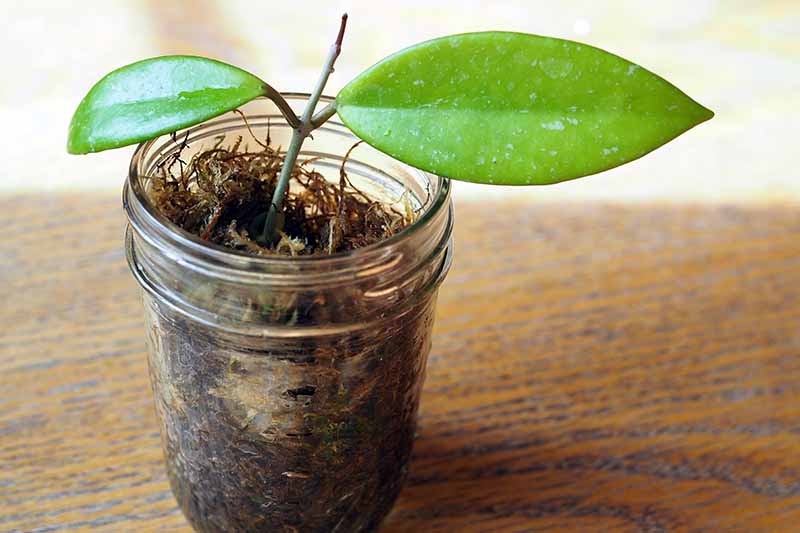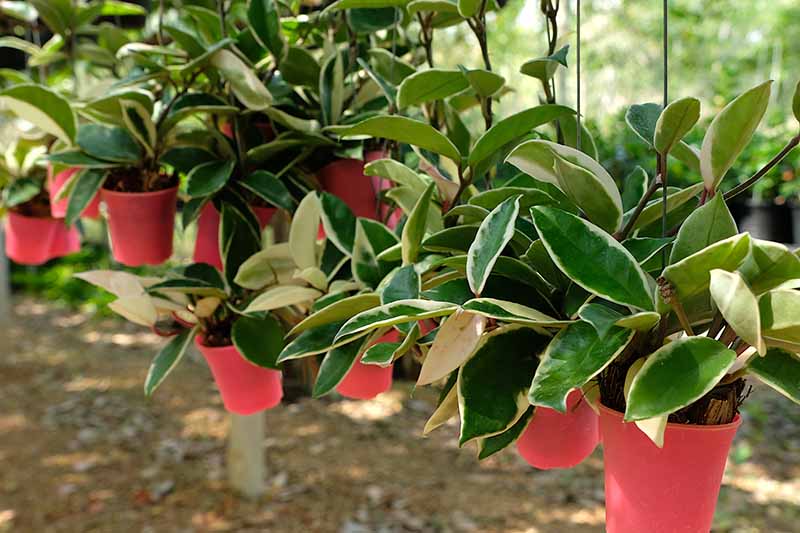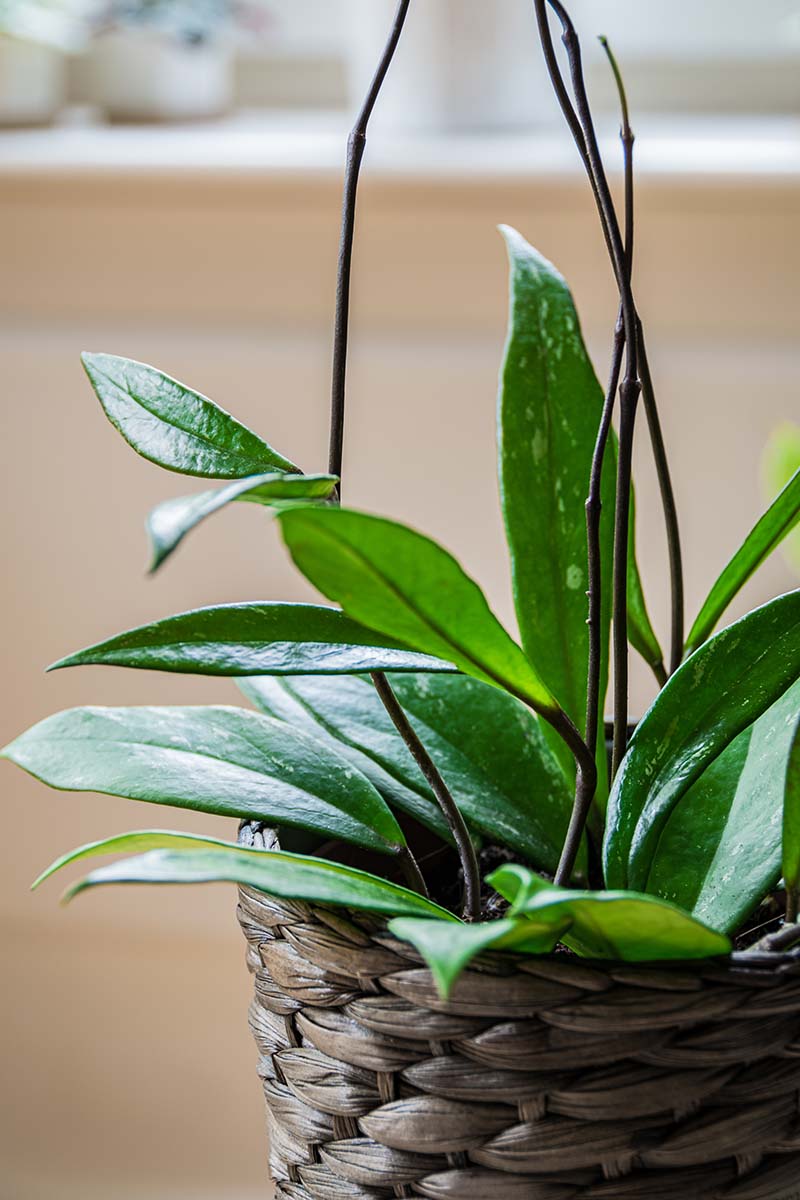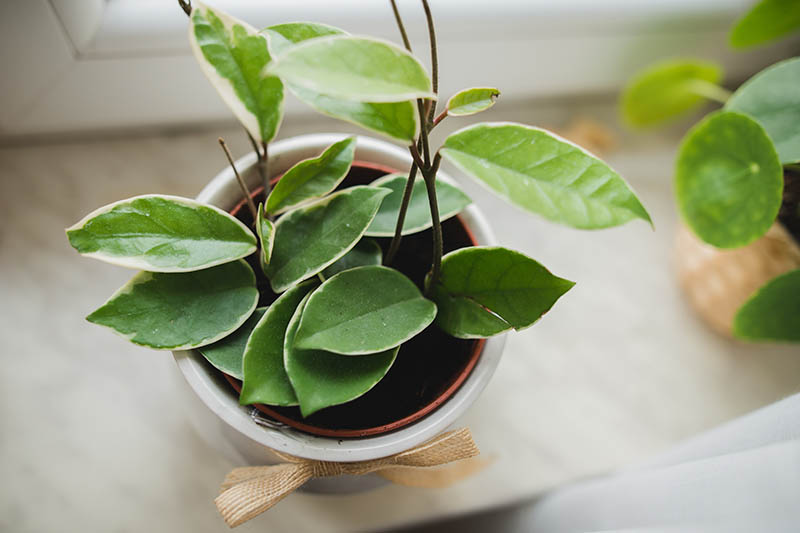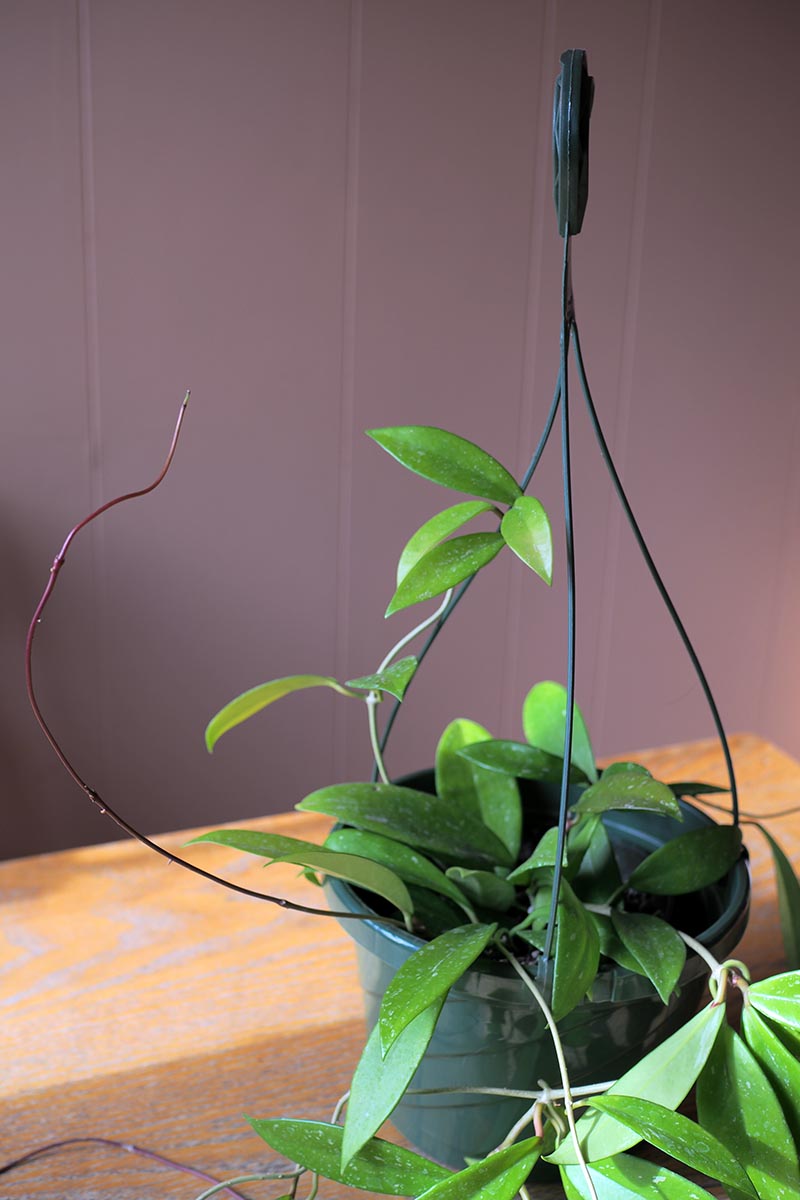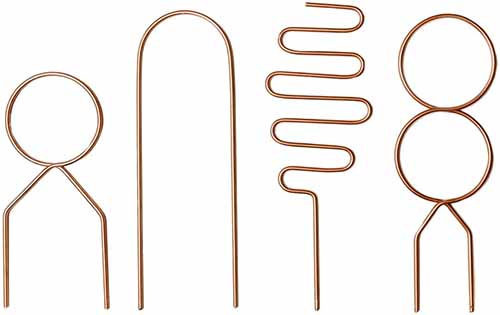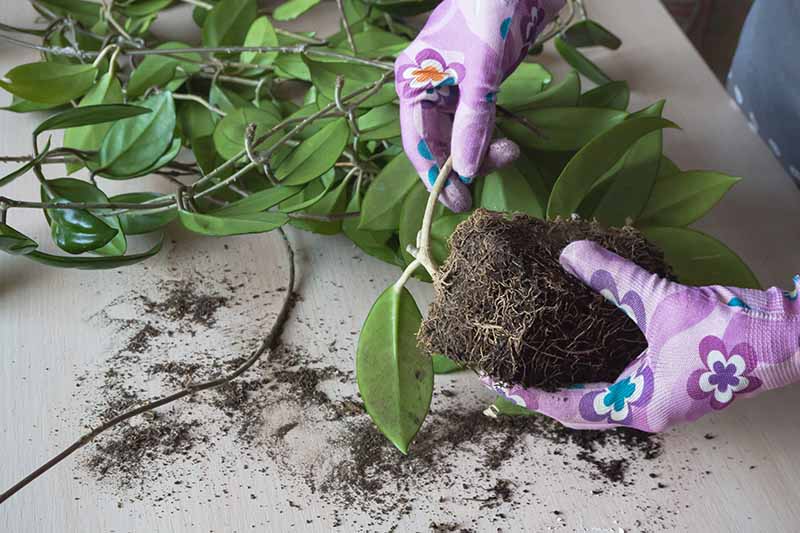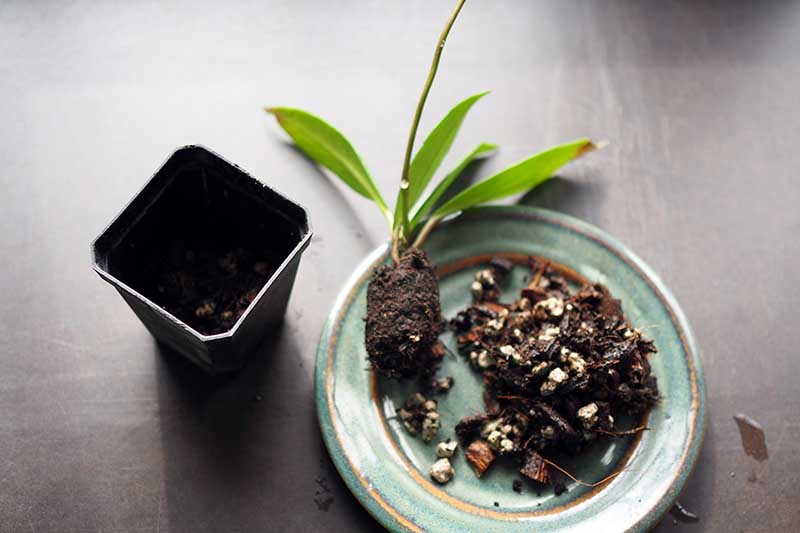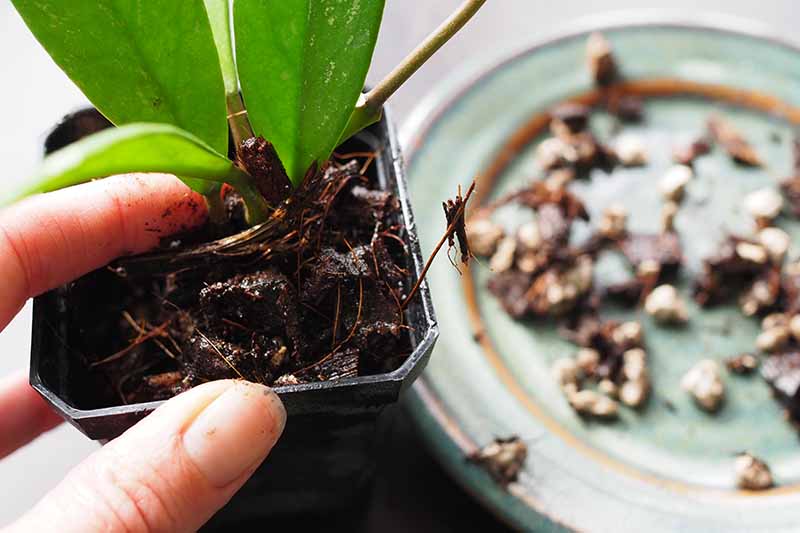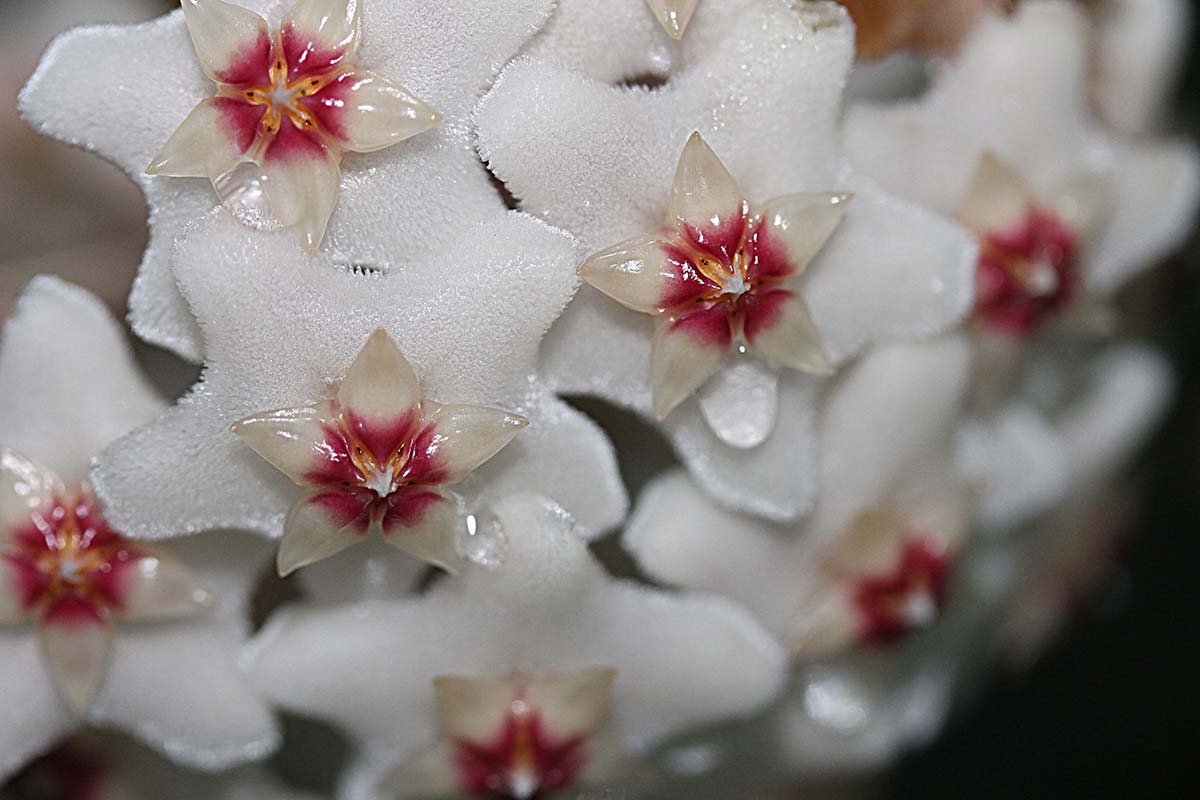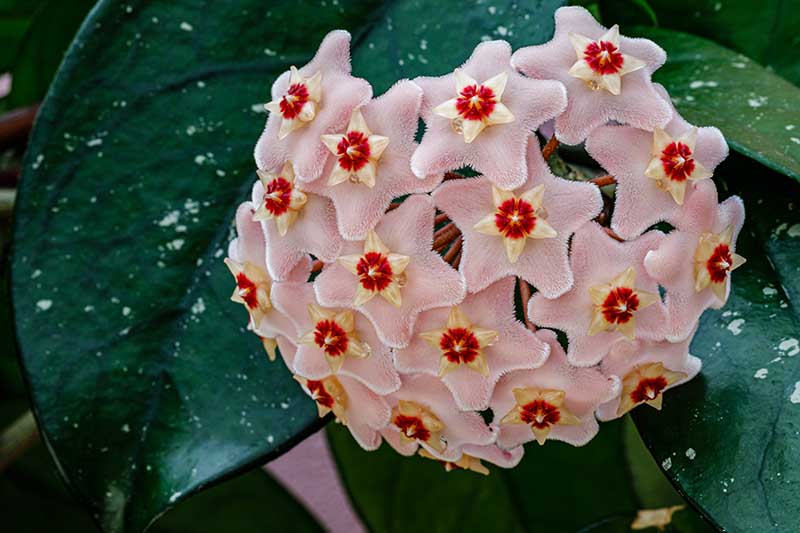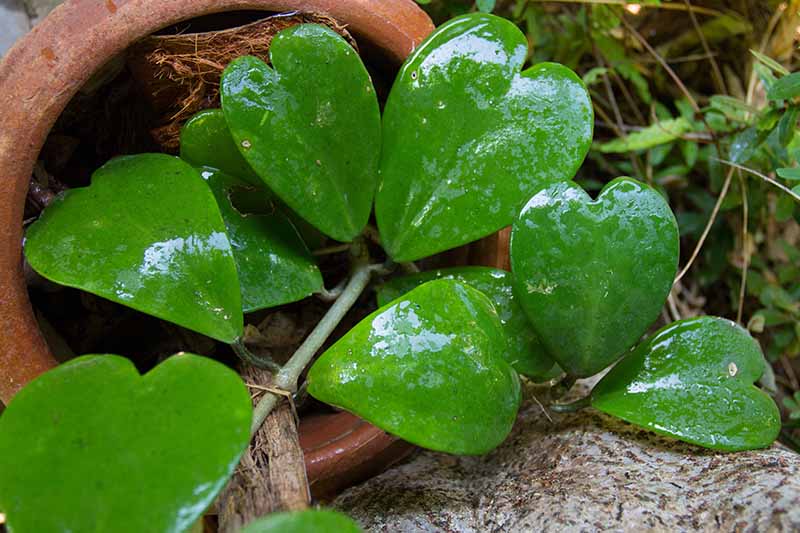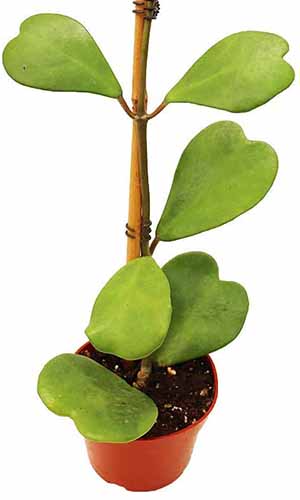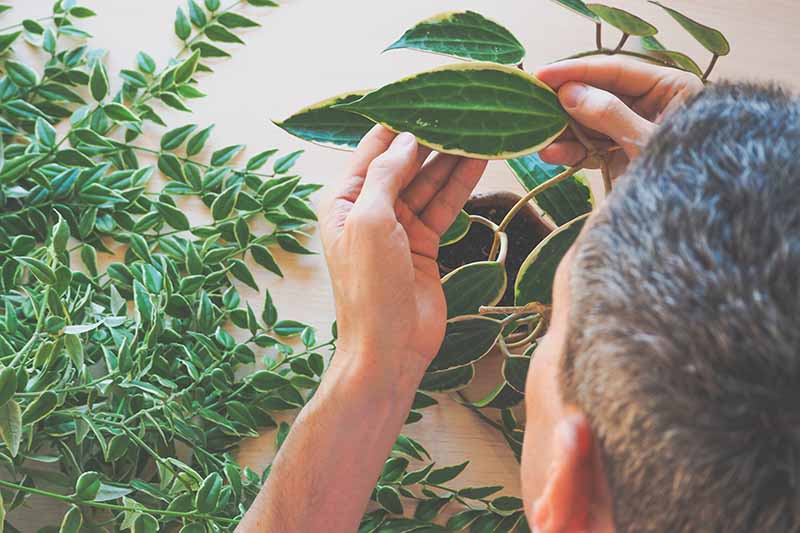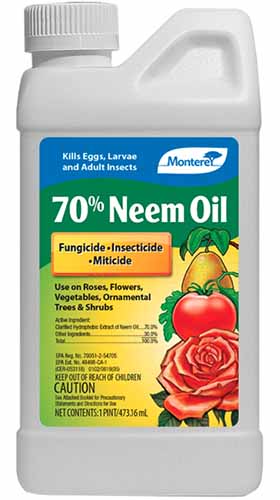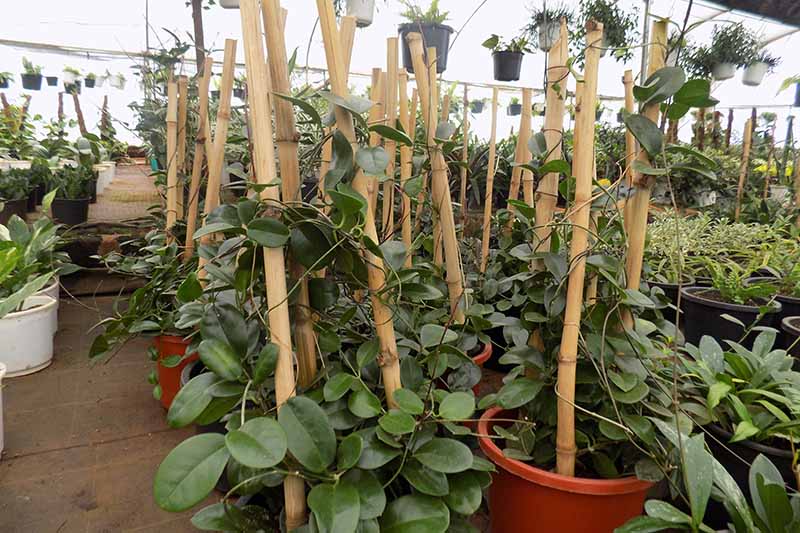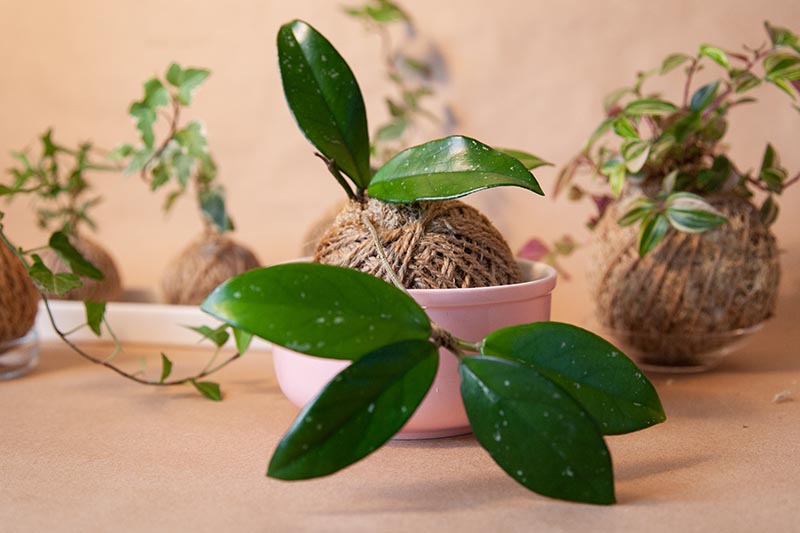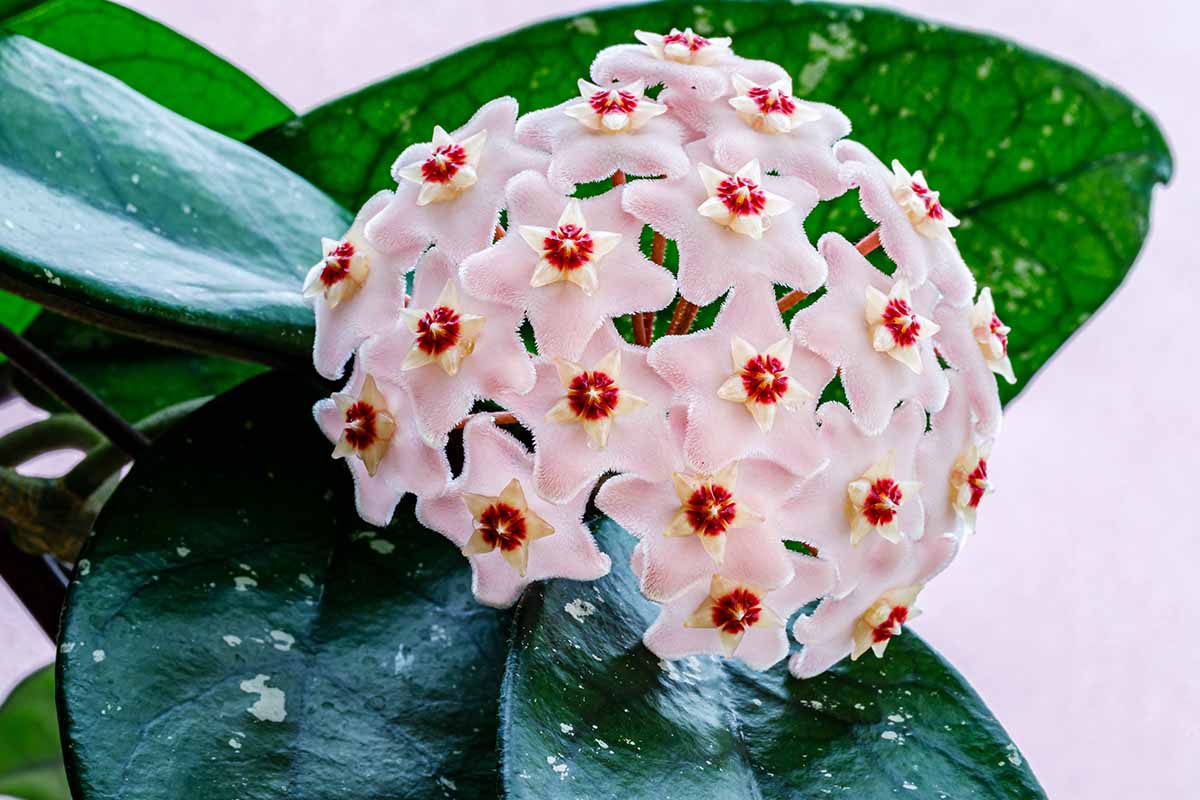One of things that makes these lovely climbing and trailing houseplants so intriguing is their vast array of leaf colors, shapes, and textures. And as if fascinating foliage weren’t already enough, hoyas can produce blooms striking and fragrant enough to compete with some of the showiest garden ornamentals, yet you can grow them indoors! We link to vendors to help you find relevant products. If you buy from one of our links, we may earn a commission. Are you ready to fall down a hoya rabbit hole with us? Brace yourself, because you may never be the same again. Here’s what we’re going to cover:
Cultivation and History
Hoya is a genus comprising vines and shrubs that are native to tropical and subtropical Asia and Oceania. The genus includes at least two or three hundred different species, though this could be an underestimate, as there are new species being discovered and described on a regular basis. Most of these species are epiphytes – in their native habitats their roots grow not in soil, but in the crevices of trees. The majority of hoyas available to grow indoors have a vining and trailing growth habit. With evergreen foliage, the numerous Hoya species available as houseplants offer a huge range of choices in leaf color, size, shape, and texture. Some have shiny green leaves, others display beautiful variegation, and some have crinkled leaves. The leaves of these plants tend to be thick and succulent, making them capable of storing water for longer periods of time. However, the foliage of some species is thinner, making those plants less drought tolerant. One thing that often puzzles new hoya plant parents is the long, bare vines of these plants, sometimes called “whips.” Vining hoya species produce these whips, which are designed to seek out trees as supports, so they can grow higher into the forest canopy. These naked tendrils will eventually grow aerial roots and leaves. Hoya flowers are generally fragrant and showy, and come in a huge range of colors depending on the species or cultivar. Flower clusters are usually rounded, small to large in size, and display individual flowers that are star-shaped and tend to have contrasting centers. Since many members of this genus are pollinated in the wild by moths, their blooms tend to be more fragrant at night than during the day. If the blooms of this houseplant look familiar, you may be noticing their resemblance to the monarch butterfly-attracting blooms of the North American native wildflower, milkweed. Hoyas and milkweeds are members of the same family, Apocynaceae, also known as the dogbane family. Along with being used as their common name, as mentioned above, Hoya is also the name of the genus these plants are classified in for scientific purposes. This genus was named by Scottish botanist Robert Brown in honor of his friend and fellow botanist, Thomas Hoy. Brown was the first to describe the genus in the scientific literature. In addition to the name “hoya,” the members of this genus are also known as “porcelain flowers,” “honey plants,” and “wax plants.” Some say they are commonly called “wax plants” because of their thick, succulent leaves, while others claim the name is inspired by their somewhat waxy-looking flowers and flower buds. While these species are used widely as houseplants, some of them also have a history of ethnobotanical use in their native habitats.
Propagation
Hoyas can be propagated from seeds, leaf cuttings, and stem cuttings, or via layering. And while many hoya species are considered to be nontoxic to pets, not every species that may be used as a houseplant has been confirmed as nontoxic. So be cautious with these plants and keep them out of reach of curious pets and kids. You don’t want your hoya collection getting chewed up anyway, do you?
However, the seeds of some of these plants are only viable for a few days, making seed propagation tricky. And when it comes to rooting leaves, most gardeners fail to produce a new plant in this way. The easiest methods for successfully propagating hoyas are by rooting stem cuttings or by layering, and we’ll cover both of these here. The process for either of these will be easier when starting with a mature plant with long vines.
From Stem Cuttings
Much like tomatoes, hoyas grow adventitious roots from their stems, making it easy to propagate them from cuttings. Cuttings will root the fastest during the warm seasons when your houseplant is in an active period of growth – however, that doesn’t mean you can’t give this fun project a try during other times of the year as well! When taking your cutting, use a pair of sterilized scissors or garden snips to avoid spreading disease. Also, make sure to include at least one to two nodes. Leave a bit of stem beneath the bottom nodes to help anchor your cutting in the potting medium. Remove the leaves from the bottom node – this is where, ideally, your new plant’s roots will grow from. While your stem cutting takes root, don’t let the rooting medium dry out – keep it damp, but not soggy. Though many gardeners are able to root these plants without it, if you’re the impatient type, rooting hormone will encourage roots to grow more quickly. If you decide to use this type of product, I recommend Olivia’s Cloning Gel, available for purchase from Arbico Organics in two-, four-, and eight-ounce containers. Olivia’s Cloning Gel Once you have your cuttings, you can also root them in a jar of water and skip the hormone gel. But some gardeners find that cuttings rooted in a growing medium tend to transition to potted life more easily than those started in water. Sphagnum moss is the rooting medium typically used for this purpose, though coconut coir makes a good alternative. I prefer Prococo Compressed Chips-N-Fiber, which is a mix of chunky coconut husks and fine coconut coir. Prococo Compressed Chips-N-Fiber It’s available for purchase from Arbico Organics in 10-pound blocks. Fill a small jar with moistened growing medium and place your cutting so that the bottom node is at the soil surface. This will encourage both root growth and the formation of new buds. Roots should start to grow within three to four weeks, and new buds will grow within about another three weeks after that. When the stem cutting’s roots are an inch or two long, it’s ready to pot up. When potting your rooted cuttings, start with a small two- or four-inch pot. You’ll find additional tips for potting hoyas a bit later in this article. After potting, keep the soil moist while the plant adjusts to its new home, gradually tapering off watering until your propagated plant is being watered at the same frequency as its parent plant.
By Layering
Layering is often an even easier method of propagation than taking cuttings. With layering, you place a vine on another pot of moistened potting mix while it’s still attached to the parent plant, allowing the vine to take root in the mix. Use a small, two- or four-inch pot with drainage holes. You’ll learn about potting medium recommendations soon, so keep reading! Once the layered stem produces roots and is securely growing in the soil, you can sever the stem connecting it to its parent plant – with a clean pair of scissors, of course. Water your hoya baby’s potting medium whenever you water the parent plant. The advantage of this method over the stem cutting method is that you won’t have to worry about transplant shock.
How to Grow
There are many different types of hoyas, so be sure to check the required growing conditions for your particular species. Following, you’ll find general growing care tips for these plants.
Choosing a Plant
Start by making sure to choose a species or cultivar that is well-adapted to your growing conditions. You’ll learn more about different types of hoyas a little later in this article. Next, choose a healthy specimen. Look for one that seems well cared for, with no yellowing or browning leaves or signs of insect infestation. You’ll learn how to spot pests on these plants a bit later as well. If you have purchased your houseplant from an online seller, once you have unpacked it and done a little happy dance, inspect it for damaged leaves and bugs. I highly recommend you quarantine it away from any other houseplants for a few days while keeping an eye open for pests that may have hitched a ride. And while your first thought might be to give your new hoya a drink as soon as it arrives, you may not want to do so with this houseplant unless it looks quite dry. You’ll learn more about watering these houseplants shortly.
Light
In the wild, most hoyas grow in dappled light. Translating that to indoor conditions means bright indirect light tends to work best. Hoyas can also grow in medium indirect light but most will not bloom in those conditions. Also, if light levels are too low, variegated hoyas may lose their variegation. If your indoor conditions aren’t bright enough, you may want to investigate options for artificial illumination. Learn about using grow lights in our article. A bit of direct sun in the morning is okay for most species, just keep it to no more than a couple of hours. For species that show nice coloring when they’re sun-stressed, make sure your plant’s leaves aren’t scorching or burning – if they are, back off on the sun exposure a bit.
Temperature
Since hoyas are tropical and subtropical species, they do well in the temperatures usually found in our heated and air-conditioned homes, around 70°F. Exposure to cold temperatures can cause leaves to turn yellow. These houseplants are not cold hardy and can be damaged by temperatures well above freezing, so make sure to always keep them above 45°F. Another way to keep these houseplants happy is to avoid cold drafts and hotspots. That means you should avoid placing them too close to exterior doors, or too close to drafty windows. Also be careful of locations close to fireplaces, heat registers, and radiators, or on top of appliances that heat up, such as the tops of fridges. Once you pinpoint a good location for your hoya, try not to move it. These plants don’t really like being moved around.
Water
In general, it’s a good habit to let your hoya dry out before watering it. Some hoya growers allow the top inch or two of the soil to dry before watering, while others prefer to let the plant’s potting medium dry thoroughly. Determining how much to let it dry out depends on many factors, including the type of hoya you have. This may mean you only end up watering your plant every two weeks, or even less frequently – how quickly your hoya dries out will depend on its potting soil, its pot, and the conditions in your home. If your plant is in a terra cotta pot as opposed to a plastic one, it will dry out more quickly. Your hoya will also need more frequent watering if it is kept in brighter, more direct light. And if the leaves of your species are thinner and less succulent, such as with H. retusa or H. multiflora, this means it has less capacity for conserving moisture and will need to be watered more frequently. Whatever species you have, plan to reduce the frequency of your watering schedule during the winter. When you do water, use room temperature rainwater, distilled water, or filtered water. How do you know if you’re getting your watering right with these plants? If the foliage of your specimen starts to feel soft rather than firm, it’s past time to water. And if you start to notice shriveling leaves, you have waited much too long. On the other hand, if leaves are turning yellow and falling off, you’re probably watering too much. While you get to know your hoya, I recommend keeping track of your watering schedule on a calendar or in your gardening journal, and adjusting as needed. Once these houseplants are more mature, the foliage on the top may make it difficult to see where you are watering, so in this case you might prefer watering your plant from the bottom. Step-by-step instructions for this technique are available in our article on bottom watering.
Humidity
Although hoyas tend to like it when you let their soil dry out, hailing from tropical and subtropical climates as they do, they also like a bit of humidity. Exactly how much will vary from species to species since they come from different native locales. Keeping the ambient indoor humidity at 30 to 40 percent for your hoyas is a good rule of thumb. These levels aren’t as high as those required by nerve plants, pileas, or certain orchids, but they are higher than what many of us have in our homes, particularly during the winter months when our heating systems dry out the air. One of the easiest ways to raise relative humidity levels for your plants is to group them together. A grouping of plants can help raise the ambient humidity levels by creating a microclimate. Another nice step to take for increasing humidity is to place a pebble tray under your plants. You can make your own – just fill a tray, plate, or saucer with small pebbles, then add water.
Soil
Most species of hoya that are kept as houseplants are epiphytes. That means they are not used to having their roots plunged into rich soil. On the contrary, in the wild, their roots grow in the shallow crevices of trees. The water in the tray will slowly evaporate, raising the humidity level around the plants. Humidity Tray Translating that into indoor needs, to start with, these houseplants require excellent drainage and do well with chunky potting mixes that allow their roots to get plenty of airflow. Native conditions vary from species to species, but in general, hoyas prefer a potting medium with a pH ranging from slightly acidic to slightly alkaline, about 6.1 to 7.3. If you want to make your own potting mix, a good basic soil recipe for hoyas consists of equal parts potting soil, pumice or perlite, and orchid bark or coconut husks.
Growing Tips
Provide bright, indirect light.Allow at least the top 1-2 inches of soil to dry between waterings.Use a chunky potting medium with excellent drainage.
Pruning and Maintenance
Over the long term, hoyas are low-maintenance plants. However, there are some care tips you’ll want to know to allow them to really thrive in your home! If you prefer to buy a premixed potting medium rather than making your own, the International Hoya Association recommends a succulent potting mix. Tank’s Pro Organic Cactus and Succulent Mix My preferred potting medium for hoyas is Tank’s Pro-Organic Cactus and Succulent Mix, which has the chunky texture and excellent drainage that these houseplants need to thrive.
Fertilizing
In the wild, these plants would be lightly fertilized by decaying organic matter. Since that isn’t on the menu when they grow in our homes, fertilizing will help make up for it.
Pruning
Pruning is certainly not a required task, but if you want to create a bushier-looking plant, this will be a useful tactic. Dr. Earth Pump and Grow Be sure to follow the manufacturer’s recommendations for using this product. You can selectively prune vines and then use them to propagate new plants. But you may also want to prune off discolored leaves. When pruning this houseplant, use sterilized scissors or garden snips. To sterilize them, wipe them with a paper towel dipped in hydrogen peroxide. This will ensure that you don’t spread any lurking diseases to your cherished plants. To prevent bacterial infection at the site of the cuts, you might employ a natural remedy: try dabbing cut stems with ground cinnamon, which is naturally antibacterial.
Trellising and Staking
Since these plants produce small aerial roots, one of the fun maintenance perks for hoyas is that you can train their vines to grow on stakes or trellises. You can even train them to grow up the hangers of their baskets rather than letting their vines cascade down. You may want to find out how long the vines of your species can grow before you choose a trellis or stake, as it can be a little tricky to unravel those vines once they’re tangled together, considering that some species’ vines can reach fifteen feet long or more.
Repotting
These species prefer to be rootbound, and don’t always respond well to repotting, so frequent repotting is not recommended. Wait until the plant is quite rootbound before you repot it. Whatever type of support you choose, also make sure it is sturdy enough. One option is to use a large center pole, such as this Blooming Jungle coco coir-wrapped wooden stake. Coco Coir 24” Wrapped Plant Pole Another option is to use a trio of slim bamboo stakes. You can space them in a teepee shape around your plant, then attach them at the top with a length of twine. This type of support will give you a pyramid-shaped mound of foliage. Finally, another option for training the vines of your hoya is to use a trellis. Your houseplant can be trained to grow on a circle, spiral, or whatever shape strikes your fancy, and can be wrapped around multiple times to create a thick mass of foliage. Four Pack Copper-Colored Small Metal Trellises When you’re ready to stake or trellis your hoya, you can tie the vines loosely to their support with twine, attach them with plant clips, or simply wrap and tuck them under each other. As the vines grow longer, you can loop them around their trellis or stake multiple times. How long this takes will depend on your growing conditions and your selected species. Check your plant’s roots every year or two and see how they look. Also, if your houseplant starts to dry out more quickly than usual, that may be a sign that it’s time to repot. Of course, there’s another reason you may wish to repot your plant – if you welcome home a new hoya that is potted in inadequate potting soil. In this case, you can simply repot the plant in the same container, changing out the potting medium. Whatever your motivation for repotting, wait if you can until the plant is in a period of active growth during spring or summer. When it’s time to repot, choose a suitable container with drainage holes, as well as a suitable potting medium. Be sure to review our recommendations for the potting medium above. Since most hoya species grow in the wild as epiphytes, they don’t have deep roots – which means they don’t need deep pots. Choosing a pot on the shallow side that is only one size up from your current container will provide enough room for your houseplant’s roots while helping to prevent waterlogging. Remove the plant from its pot. If you are changing out the potting mix, gently remove some of the soil from around the roots. If you are using a large stake, this is the time to position it in your pot. For lighter-weight trellises or stakes, you can position the plant before adding these. Place some of your new potting mix in the bottom of the pot. If your plant is very rootbound, rub the sides of the roots to help loosen them up a bit, to make it easier for them to adapt to the new potting mix. Combine just a little of the old soil with the new potting mix. This will help water to transfer between the old soil and the new, and may help to give your plant an easier transition. Situate the plant into its new pot, making sure to leave half an inch or so between the rim of the container and the surface of the potting medium. If the soil is too close to the rim, you’ll make a mess when you water, with dirt running out of the pot from the top. Once your plant is centered and settled, backfill with potting mix. If you’re using a lightweight stake or trellis, put it into position now. Water in your newly repotted plant and return it to its previous location.
Encouraging Flowering
If you’ve brought a hoya into your home in the hopes of coaxing it to bloom, be aware that these species will only bloom once they reach maturity, and the amount of time needed to reach maturity will vary both among different species, and among individuals of the same species. First and foremost, bright, indirect light is essential to encourage flowering. Another important thing you should know is that flowers form at the end of small flower stems called “peduncles.” Since flowers typically emerge from the same peduncle time after time, you’ll want to take care not to prune those off. Another factor that can affect your houseplant’s ability to bloom is your indoor climate. Hoyas produce nectar from their flowers – some species more than others – and this nectar can be somewhat messy indoors. Finally, a special fertilizer with a higher phosphorus content can also help. In addition to their houseplant formula, Dr. Earth also offers a fertilizer to encourage flowering. Dr. Earth Pump and Grow Bloom Booster But before you decide to fill your home with the sweet smell of hoya flowers, there’s one more thing you should plan for: You may want to situate your houseplant accordingly to avoid having nectar drip on furniture or rugs.
Cultivars to Select
The hardest thing about growing a hoya might be deciding which species or cultivar to choose. Here are a few options to get you started:
Managing Pests and Disease
Sometimes a houseplant enters your life and stays there without ever presenting the least sign of pest or disease problems, and that may turn out to be the case with your hoya as well. But just in case, it’s good to know what to be on the lookout for. Making it even more versatile, it comes in a wide range of spectacular varieties. But for now, we are going to focus on the naturally occurring species. Native to humid subtropical forests in China, Japan, Laos, and Taiwan, and adapted to low to moderate humidity, H carnosa is very well-suited to the climates in our homes. Its leaves are dark green and sometimes flecked with white or silver. They are elliptical in shape, and quite thick, making the plant less prone to drying out. The flowers of H. carnosa are fragrant, slightly fuzzy, and white to pale pink with red centers. They will start blooming when plants are about three years old. Carnosa vines can grow to be fifteen feet long or more – but don’t worry, it may take twenty years for them to reach that length. And if you don’t want a home full of long vines, you can always propagate cuttings for your friends and family. This epiphyte can handle more direct sun than some of the other species but it will also be happy in bright, indirect light. And if you need one more reason to convince you of the merits of H. carnosa, this species received the Royal Horticultural Society’s Award of Garden Merit in 1993. H. Carnosa Live Plant in 4” Pot You’ll find live plants in four-inch pots available for purchase from The House Plant Shop via Walmart.
Hindu Rope
Hindu rope is a cultivar of H. carnosa, known officially as H. carnosa ‘Compacta.’ Its green leaves are twisted and curled up on themselves, giving its long vines a thick, chunky look which is simply stunning on mature plants. The fragrant flowers of this fascinating variety are pale pink with red centers. Being a cultivar of H. carnosa, this houseplant has the same growing requirements. H. Carnosa Hindu Rope Live Plant in 6” Pot You can purchase Hindu rope in a six-inch pot from the House Plant Shop via Walmart.
Kerrii
Known as “sweetheart plant,” “waxhearts,” or ”valentine hoya,” H. kerrii is another of the most popular species, particularly around Valentine’s Day. Native to Cambodia, Java, Laos, Malaysia, Thailand, and Vietnam, this species has large, heart-shaped leaves that are quite thick. A slow grower, this epiphyte has white flowers with russet centers. It prefers moderate humidity, between 25 and 49 percent. This type is usually priced based on the number of leaves on the plant, making mature specimens relatively expensive compared to some other types. Learn more about growing sweetheart hoya in our complete guide. H. Kerrii Live Plant in 4” Pot This selection reveals just the tip of the iceberg when it comes to the many different types of hoyas that you may wish to grow. To learn more, make sure to read our article on 29 of the most fabulous hoya cultivars and species. Inspect your plants regularly so you can catch any problems before they get out of hand. It’s also a good idea to inspect new specimens before you add them to your houseplant collection. Even if they look healthy on initial inspection, you may want to quarantine them for a week or so before mixing them in with your other houseplants. Here are the most common pests and problems to be on guard against.
Insects
There are a few pests which seem to favor hoyas, and these are the ones you’re most likely to encounter:
Aphids
Aphids don’t just colonize your rose bushes and kale crop – they can also attack your houseplants. These tiny insects can suck nutrients from the leaves of your plants, weakening them and stunting their growth. If you find an aphid infestation on your hoya, first try taking it outside (weather permitting) and spraying it with a jet of water from your garden hose. Then examine your plant and pick off any remaining aphids by hand. If you try this tactic and it doesn’t work, repeat it, but follow it up with an application of nontoxic neem oil. To learn more about these pests, be sure to read our article on controlling aphids.
Mealybugs
What looks like bits of fluff but sucks the life out of your houseplants? Mealybugs, that’s what. These insects, disguised as bits of hair or fur, are frequently found crowding the stems of infested houseplants. Like aphids, they suck nutrients from the plants they colonize, sickening the plants and preventing them from thriving. These may be the most frequently found among pests that may infest hoya houseplants. They can be particularly hard to remove from Hindu rope hoyas because of their curled-up leaves. If you discover an infestation, follow the same strategy as with fighting aphids. First, try removing them with a strong spray of water. If that fails, fall back to that favorite nontoxic insecticide and fungicide, neem oil. Apply the product according to the manufacturer’s instructions. A week later, check your plant again. If you find any bugs, they should now be dead. If they’re not, pick them off, then reapply. In some cases, mealybugs can also infest the roots, so if you treat your plant and the mealybugs keep coming back, you may need to treat the roots as well. For more information about controlling these pests, read our guide to mealybug pest control.
Scale
Related to mealybugs, scale are small insects masquerading as specks of dirt or blemishes. When scale insects have set up camp on your houseplants, you may think you’re seeing the signs of some disease. These insects have a domed covering that enables them to blend in with the leaves. And under that cover, they are feeding on your plants. Scale insects particularly like to hang out next to leaf veins, where they can be very hard to spot.
Disease
Most diseases and noninfectious physiological conditions that occur in hoyas can be prevented. Here’s a quick rundown of the basics: If it seems like a good idea to keep a bottle of neem oil on hand in case one of these pest problems arises – and it is! – I recommend Monterey neem oil, available at Arbico Organics. Monterey Neem Oil To find out more about your options for fighting scale, read our guide.
Botrytis Blight
Are you seeing large gray patches on the leaves of your plant? If so, botrytis blight might be to blame. This fungal disease also affects hydrangeas, roses, and many other garden perennials, as well as other houseplants such as African violets. Also known as gray mold, this disease is caused by fungal species in the Botrytis genus that can colonize the foliage of your hoya when conditions are cool and damp. In addition to causing gray spots on the foliage and stems, Botrytis blight can cause brown spots to appear on the flowers. Affected leaves can eventually turn mushy, and powdery gray spores may be visible. Neem oil can be applied as an organic fungicide, but it’s also important to address any issues that led to the development of the disease in the first place. Avoid misting your hoyas when conditions are cool or at night. Also, rather than watering over the foliage, pour water only onto the soil. Finally, while grouping plants together can be helpful when humidity is low, make sure spacing is adequate to allow for airflow.
Edema
Edema is a physiological disorder that can occur in hoyas when they receive too much water too fast. When the plant is unable to rid itself of excess water quickly enough, some of the plant’s cells become overfilled with liquid. This causes them to first stretch out, and then to collapse. A plant owner may first notice bumps on the undersides of leaves, which may eventually become tan-colored and corky. These spots may eventually turn black. Also spelled “oedema,” this condition is not contagious, and its effects are primarily aesthetic – though with severe cases, the plant’s ability to photosynthesize can be impaired. The only treatment for edema is prevention, so if you encounter this problem, examine your plant care routine. You may need to get your watering on a more regular schedule, water in the morning instead of in the evening, increase air circulation, or reduce relative humidity. Making sure to use a well-draining potting medium and watering plants less during periods of cloudy, chilly weather will help as well. Angela Madeiras, a diagnostic technician at the University of Massachusetts Amherst Extension, also recommends being careful not to overfertilize. Affected leaves will continue to bear the marks of this condition, but if growing conditions are improved, new leaves will be unblemished. Since only the underside of the foliage is usually affected, I recommend leaving it on the plant, at least until new leaves have grown in to replace the damaged ones.
Root Rot
Root rot is a disease often caused without intention by an overly attentive plant parent. Yellow leaves may be the first sign of a problem, and in hoyas, they may start to fall off. This disease is caused by overly soggy soil conditions which allow fungal pathogens to proliferate. Sometimes it’s caused by overwatering, sometimes by inadequate drainage, and other times allowing a plant to sit in a saucer of water is to blame. An excess of water around your hoya’s roots will eventually deprive the poor plant of oxygen. Then the roots will rot, and the plant will die from dehydration. Since you want your dear little hoya to have a long and healthy life, it’s important to be aware of this potential problem and go easy on the watering. If root rot appears to be an issue with your plant, identify the problem – or problems. Then repot it into fresh, well-draining soil, but first examine the roots and trim any that are dead or rotting. Also be sure to take steps to prevent soggy soil in the future.
Best Uses
Hoyas can be used in a variety of different ways in the home. Their trailing vines will look beautiful in a hanging basket. But they can also be trained to grow upwards on a trellis, stake, or any other support instead of hanging down. You could also train one to grow along the top of a wall, or along some other horizontal surface. Since their water requirements are low, they can also be mounted on kokedamas. At least some hoya species are classified as nontoxic for pets, including H. kerrii, H. pubicalyx, and H. carnosa, making these better replacements for households with pets than other toxic vining houseplants such as pothos. And if you’re looking for plants to improve your air quality, researchers at the University of Georgia at Athens found that H. carnosa excels at removing indoor air pollutants. Here’s a quick recap of what we learned: keep your hoya in bright, indirect light; water infrequently; make sure the potting mix is very well draining – and start making plans for what to do with all those vines! What has your experience been with your own hoya? Have you been lucky enough to see yours in bloom? Let us know in the comments below, and feel free to show off your pics! And if you’re looking for some good houseplant companions for your hoya, here’s a bit more reading to give you some ideas:
11 Easy-Care Exotic Succulents to Grow at HomeOrchids 101: How to Grow and Care for Orchids23 Colorful Houseplants to Warm Up Your Home This Winter
